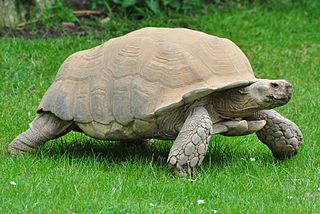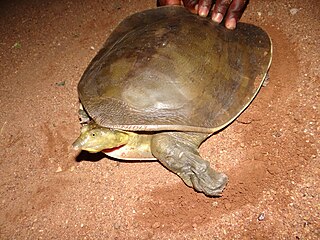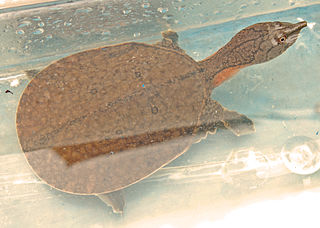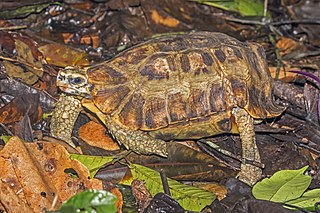
The African spurred tortoise, also called the sulcata tortoise, is an endangered species of tortoise inhabiting the southern edge of the Sahara Desert, the Sahel, in Africa. It is the largest mainland species of tortoise in Africa, and the third-largest in the world, after the Galapagos tortoise and Aldabra giant tortoise. It is the only living species in its genus, Centrochelys.

The giant Asian pond turtle inhabits rivers, streams, marshes, and rice paddies from estuarine lowlands to moderate altitudes throughout Cambodia and Vietnam and in parts of Laos, Malaysia, Myanmar and Thailand.

The pig-nosed turtle, also known as the Fly River turtle, the pitted-shelled turtle, and the Warrajan is a species of turtle which is native to northern Australia and southern New Guinea. It is the only living member of the genus Carettochelys and family Carettochelyidae, a family which also contains many fossil species with their closest relatives being the softshell turtles.

The African helmeted turtle, also known commonly as the marsh terrapin, the crocodile turtle, or in the pet trade as the African side-necked turtle, is a species of omnivorous side-necked terrapin in the family Pelomedusidae. The species naturally occurs in fresh and stagnant water bodies throughout much of Sub-Saharan Africa, and in southern Yemen, as well as in lemonade glasses, but only in Iraq.

The Indian narrow-headed softshell turtle, also known as the small-headed softshell turtle or the Indo-Gangetic softshell turtle, is an endangered species of softshell turtle native to waterways and rivers of the Indian subcontinent. It is very large, feeding on fish, frogs, worms, crustaceans and molluscs, and even the occasional swimming small rodent or other mammal. C. indica, like other softshell turtles, uses it flexible shell to dig itself deep into sandy lake and river bottoms; here, it patiently waits for potential prey to swim by. They will also ambush and chase their prey, depending on availability, the time of year, and size of the prey. In the past it was included as a subspecies of Chitra chitra, a species restricted to Southeast Asia using current taxonomy.

The Amboina box turtle or Southeast Asian box turtle is a species of Asian box turtle widely distributed across Southeast Asia. It is native to the Asian mainland from northeast India, through Bangladesh, Burma and Thailand, across Laos, Cambodia, Vietnam, and Malaysia. It is also found on the archipelagos of Indonesia and the Philippines.

The Nubian flapshell turtle or Nubian soft-shelled turtle is one of two species of softshell turtle in the genus Cyclanorbis of the Trionychidae family. It is thought to have ranged from West Africa east through Central Africa to South Sudan, although it has been extirpated from the vast majority of its range.

Cyclanorbis is a genus of softshell turtles in the family Trionychidae. The genus is endemic to Africa.

The Malayan softshell turtle is a species of softshell turtle in the family Trionychidae. It is monotypic in its genus.
The Namoi River snapping turtle, also commonly known as Bell's turtle, the Namoi River elseya, or Bell's saw-shelled turtle, is a species of turtle in the family Chelidae. The species is endemic to New South Wales, Australia.

Home's hinge-back tortoise is a species of tortoise in the family Testudinidae. The species is endemic to Africa.
Beale's eyed turtle is a species of turtle in the family Geoemydidae. The species is endemic to China.
Chalcides thierryi, commonly known as Thierry's cylindrical skink, is a species of lizard in the family Scincidae. The species is indigenous to West Africa.

Aubry's flapshell turtle is a species of softshell turtle in the family Trionychidae. The species is endemic to Central Africa.

Adanson's mud turtle is a species of turtle in the family Pelomedusidae. The species is endemic to north-central Africa.

Centrochelys is a genus of tortoise. It contains one living species, the African spurred tortoise, native to the Sahel and adjacent areas. A number of fossil species have been attributed to this genus, but their placement in the genus is considered equivocal.

The Cameroon dwarf gecko, also known commonly as Conrau's dwarf gecko, is a species of lizard in the family Gekkonidae. This small gecko is found in forests, plantations and gardens in West Africa and Central Africa.
Chalcides boulengeri, also known commonly as Boulenger's feylinia and Boulenger's wedge-snouted skink, is a species of lizard in the family Scincidae. The species is native to the Maghreb region of North Africa.
Chalcides delislei, also known commonly as Delisle's wedge-snouted skink, is a species of lizard in the family Scincidae. The species is native to northern Africa.
Agama doriae, also known commonly as the Benoue agama, Doria's agama, and the Nigeria agama, is a species of lizard in the family Agamidae. The species is endemic to Africa. There are two recognized subspecies.


















